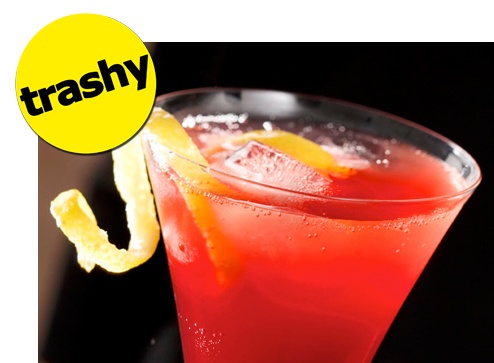1. Kir Royal
1 ounces crème de cassis
5 ounces champagne
My pick for the ultimate graduation cocktail is the Kir Royal. If you’re at the point where a simple, elegant flute of champagne isn’t enough to commemorate the completion of your studies, then it’s time to break out the crème de cassis, a sweet but tart black currant liqueur that pairs perfectly with dry champagne. This couldn’t be easier to make; fill a flute one-fifth of the way full with crème de cassis, and top with champagne. As the champagne’s carbonation activates the thick, syrupy liqueur, the drink will turn a luscious, deep pink color.
2. Champagne Punch
Lots of fruit
Brandy
Cointreau
Bottles of Brut Champagne
Ice
This drink is excellent when celebrating with a large group. In allowing for wide variation of taste and ambition, this punch is both versatile and reliably non-controversial, able to please a variety of drinkers. Begin by adding rind, pulp, leaves, and/or slices of any of the following to a large bowl: oranges, grapefruit, lemons, pineapple, cherries, strawberries, and mint. Add brandy and/or Cointreau (a version of the orange liqueur triple sec) and a bottle of club soda. Stir until ingredients are mixed, then top with several bottles of Brut Champagne. Finish with lots of ice just before serving to avoid diluting the mixture before it can be fully enjoyed.
3. French 75
2 ounces London dry gin
1 teaspoon powdered sugar
0.5 ounces lemon juice
5 ounces Brut Champagne
Anyone who served in France during the Great War should recognize the name of this drink. It comes from the Canon de 75 modèle 1897, a type of 75-millimeter anti-personnel field artillery gun. They were a big deal—at Verdun, over 1,000 “75s” were kept in constant use for what must have been a very loud period of over nine months. During the war, someone at Harry’s New York Bar in Paris borrowed this gun’s name for a new drink rumored to have a kick that felt like being shelled by the beloved French “Soixante Quinze.” In a cocktail shaker, combine the gin, sugar, and lemon juice; shake vigorously. Strain into a glass, top with ice, and add nearly a full flute of champagne.
4. Bellini
2 ounces peach purée (or nectar*)
5 ounces Prosecco
The Bellini was invented in Venice, and thus is technically supposed to be made with Prosecco, Italy’s Champagne equivalent. Champagne’s richness allegedly does not pair well with the peach nectar, and so Prosecco remains a popular choice even today. The peach nectar turns the sparkling wine deep pink. Allegedly this hue reminded the drink’s creator, Giuseppe Cipriani, of a painting by the 15th-century artist Giovanni Bellini, hence the name. Simply combine the peach and Prosecco in a glass and enjoy!
*For a truly authentic nectar, the peaches are cut a day or two in advance and allowed to soak in a sweet white wine before being puréed and sweetened with sugar. This is the difference between peach nectar and peach purée or peach juice, which is not sweetened. Many stores sell both nectar and purée.
5. Champagne cocktail
1 sugar cube
Bitters
1 ounce brandy (optional)
Brut Champagne
It’s hard to beat the classic champagne cocktail, which uses sugar and bitters to add flavor and sweetness to dry champagne. But be advised that expensive champagnes won’t be able to stand up to the intensity of the bitters and sugar, so save the Dom for later and use something a little more down-to-earth.
Begin with a chilled champagne flute. Add one sugar cube and bitters, in dashes (usually 3–4), stirring until the sugar is dissolved. (Angostura bitters are preferred.) Add brandy. Fill the flute with Brut Champagne, but be careful, because the champagne will foam violently when it comes into contact with the sugar mixture. Top with a cherry or orange pith garnish, which will pair nicely with the aromatics in the bitters.
Author’s Note:
By definition, the sparkling white wine called Champagne comes from the rolling hills of the northeastern French region that supplies its name. Because of complicated legal rules governing appellation, sparkling white wine made outside this region is not technically Champagne. But whether we call it Cava (from Spain), Prosecco (from Italy), California sparkling white, or bubbly, the principle is the same. The double fermentation process that gives champagne its bubbles adds a costly step in the production process, transforming this white wine into a luxury product commensurate with the honor, hassle, and catharsis of graduating from the University of Chicago.
Champagne and other sparkling white wines (which can be used interchangeably in all these recipes) are classified according to sweetness: “Extra Brut” has six grams of sugar per liter, followed by “Brut,” which has less than 12, “Extra Dry,” “Sec,” “Demi-sec,” and, finally, “Doux,” which has over 50 grams of sugar per liter. Many of these drinks capitalize on the effervescence of the wine and pair a dry (less sweet) champagne with a sweet liqueur or fruit juice. They are also predicated on having very, very cold champagne, so make sure that the wine you use is super chilled. The Mimosa, a brunch and graduation staple, is not present on this list, but deserves an honorable mention—it can be made by simply combining champagne and orange uice in whatever quantities are preferred.









